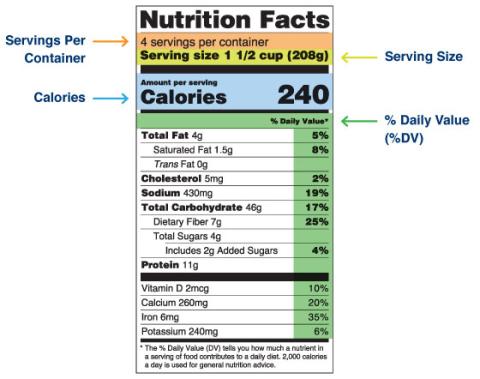Food Label Facts for Older Adults
If you are an older adult, you probably remember the days when the label of a can of soup or a box of cereal had no information beyond a list of ingredients. But over the years, government regulations mean consumers have a lot more information about the food products they purchase, found on the standard Nutrition Facts Label that the U.S. Food and Drug Administration (FDA) made mandatory for manufacturers in 1990.
These labels allow us to make better food choices, but many people are unsure of how to interpret and use that information. Here is a quick overview of the parts of that familiar label.
The format of the label may vary depending on the package. If the package is small, you might need a magnifying glass! But in general, the following are things the manufacturer is required to list, and tips for using that information:
Servings per container. One package of food may contain more than one serving. Remember that if you eat or drink two servings, you are getting double the calories and double the nutrients that are listed on the label.
Serving size. This is based on the amount of food an average person might eat at one time—although it might not be the amount that you typically eat, so check carefully.
Calories. This is the calorie count per serving.
% Daily Values (%DV). The column shows how much of a particular nutrient a serving of food contributes to a total daily diet. For example, if you eat one serving of a food and it provides 10% DV of dietary fiber, then for that day, you have eaten 10% of your dietary fiber daily goal.
Fats. Some fats are much healthier than others. The label separates out less-healthy saturated fats, and may note the amount of more healthy monounsaturated and polyunsaturated fat. Trans fats are especially unhealthy; most were phased out in 2018.
Cholesterol. Consuming too much of this substance is unhealthy. Ask your doctor about your personal recommended daily limit.
Sodium. This mineral, commonly found in table salt and many processed foods, can contribute to a number of health problems. Most older adults consume far more sodium than they should.
Total carbohydrates. This number includes substances that provide energy for the body.
Dietary fiber. This type of carbohydrate helps maintain good digestion, and may reduce the risk of heart disease. The FDA reminds older adults to consume an adequate amount of dietary fiber.
Total sugars. Some sugars are naturally occurring; the label also shows the amount of added sugars in the product.
Protein. This substance is needed for normal body functioning; the FDA says many older adults don’t consume enough protein.
Nutrients, vitamins and minerals. The manufacturer is required to state the per-serving %DV of vitamin D, potassium, calcium and iron. They also can list other vitamins and nutrients. The FDA recommends that older adults select foods with a higher %DV of calcium, vitamin D and potassium.
The information in this article is not intended to replace the advice of your health care provider. Talk to your doctor about your calorie needs and a diet that’s right for you.
